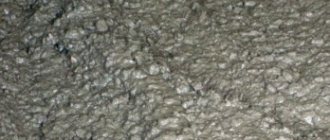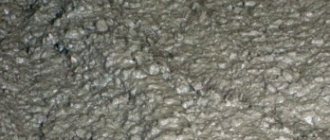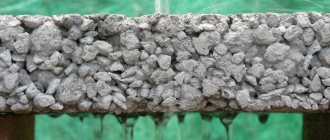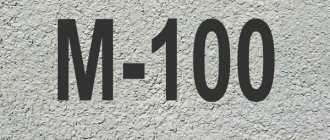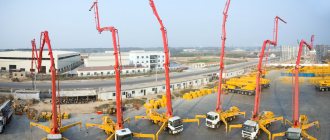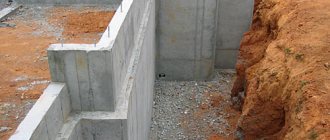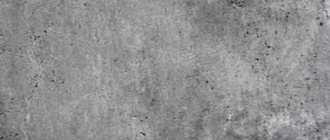When constructing buildings and structures for various purposes, the choice of materials, in particular mixtures, plays an important role. Cement, which is used for a wide range of construction and finishing works, can be of different brands, and its technical characteristics and operating features depend on this. M150 cement is one of the most common brands, which is used for laying walls made of block, stone and brick, as well as plastering walls.
This solution is environmentally safe, resistant to high temperatures and fire, plastic and easy to apply. Cement 150 can be used for both external finishing and internal work. The mortar used for finishing work contains small grains of sand, which makes the surface of the wall smooth and even, and the percentage of sand itself in it is higher, in contrast to concrete of the same brand.
Characteristics: ready-made masonry cement mortar grade 150 (composition, density, specific gravity)
The durability of buildings depends on the quality of building materials, including different grades of cement. Based on it, a widely used ready-made masonry cement mortar of grade 150 was created. This composition is used in the construction of brick and block houses; it is used to plaster walls from the outside and inside.
Comparison of cement brands.
In accordance with current regulatory documents, concrete m150 class B10-B12.5 has the following consumer characteristics:
- Compressive strength of M150 concrete: 130-160 kg/cm2.
- Frost resistance: 75-150 freeze-thaw cycles.
- Water permeability: W2-4.
- Concrete weight m150 (1 m3): 2275 kg.
- Bending strength: 10 kg/cm2.
- Mobility: P1–P4.
- Density of concrete m150: 2275 kg/m3.
- Setting speed: fast setting.
How much does cement M 150 cost? Averages
The price of products of this brand can range from 100 to 300 rubles per bag with a standard weight of 25 kg. Such changes are related to what kind of cement is purchased, where it was mined, and who sells it. Purchasing material directly from the factory will be approximately 30-40% cheaper, therefore, if price is of great importance, then it is better not to look for resellers, but to contact the manufacturer directly, especially if you need to buy a large batch of bags: its factory may provide a discount or get free delivery.
M150 is a grade of cement that is used for the widest range of works in construction. Mixtures based on it are distinguished by high performance properties, and its reasonable cost allows it to be used in large quantities even for the construction of houses with expensive materials. Also read about the difference between M300 and M400 cement here.
Specifications
The performance properties of mortars completely depend on their technical characteristics. These indicators for M150 concrete are regulated by GOST 7473-2010. These include:
- The strength indicator is in the range of 131-164 kgf/cm², determined in laboratory conditions. The maximum is achieved after complete hardening and completion of the cement hydration reaction. Compressive strength is intermediate between concrete classes B10 and B12.5.
- The average density of this material is 2200 kg/m³. For M150 concrete, this characteristic specified in GOST may change insignificantly due to the use of different fractions and types of fillers.
- The mobility of the composition varies from P1 to P4, this indicator depends on the proportion of water used in the preparation of the mixture.
- Water resistance corresponds to class W2. Therefore, it is advisable to use it with additional waterproofing, since the material actively absorbs moisture, which can destroy its structure.
- Frost resistance F50 is an indicator corresponding to the number of freezing and thawing cycles without reducing the strength of the composite.
- M150 mixtures belong to the class of quick-setting materials, this is taken into account during installation.
Cement M150: technical characteristics and advantages of the mixture
Complex mortar 150 is prepared from a mixture of cement, sand and water. You can work with this brand of cement at positive temperatures: from +5 to +30 degrees Celsius. The solution has high compressive and tensile strength: from 15 MPa and from 3 MPa, respectively. The finished mixture hardens within 40-60 minutes, so wall laying or plastering can be done fairly quickly. M150 is a mixture that has high bonding strength with other materials, and this is another reason why it is convenient to use for finishing. The frost resistance level of this brand of cement is at least 25 cycles.
There is also such a variety of material as oil well cement PCT I SS 150: it is used in various fields of activity, from construction and finishing to the creation of wells, and most often it plays the role of a waterproofing agent. It is mixed with water, where it has a higher percentage in the composition, and the finished mixture hardens very quickly, creating an excellent layer that does not allow moisture to pass through or absorb it.
The main advantages of grade 150 cement include the following qualities:
- Creating an even layer, which is convenient for both plastering and laying walls. No cracks or chips should form on the layer of mortar prepared from this brand of cement, unless errors were made during the process.
- Due to its high strength, this grade can be used for construction from any type of stone. You can also use this material for external cladding with artificial stone.
- The density of the resulting solution when hardened is uniform over the entire area of application.
- High frost resistance allows you to work with cement of this brand in most regions of the country: the resulting structure will be stable even in the northern region.
Solution preparation technique
- The required amount of dry mixture is added to clean water, preferably at a temperature not lower than +15°. The average consumption is about 10 kg per 2 liters of water. More precise dosage depends on the manufacturer. Information about it is available on the packaging.
- The mass is thoroughly mixed until the lumps completely disappear. The resulting solution must be absolutely homogeneous.
- The mixture is kept for 5-10 minutes and mixed thoroughly again. The solution is ready for use. It must be used within 2 hours.
Attention! The solution is prepared using personal protective equipment. Dry mixtures generate a lot of dust, and when in contact with water they give an alkaline reaction.
How to calculate the required amount of solution
To calculate the amount of solution, you need to know:
- work area;
- recommended consumption;
- layer thickness.
The calculation is carried out by multiplying all three quantities. In addition, the application method has a significant influence on the consumption of the mixture. With a manual solution, 20-30% more will be required.
Recommendations for carrying out work
Basic rules when carrying out work:
- It is recommended to carry out all work at positive temperatures. The base temperature must be at least +5°.
- Relative air humidity should be no more than 80%.
- When the layer thickness is more than 30 mm, masonry mesh must be used.
- The next layer is applied only after the previous one has dried.
- Finishing work begins no earlier than 24 hours after the last layer has dried.
- When additional additives are added to the composition, the properties of concrete may change. For example, it will dry faster or longer, the plasticity of the mixture will increase, etc.
- You cannot knead a large volume at the same time. After setting, the mixture loses its properties.
Features of using cement PC 150
This substance can vary in composition, and the most common form is Portland cement, which is extracted from clinker, i.e. limestone stone, and has the highest operational properties. It is used for finishing work, screeding floors, laying walls, as well as a number of repairs that require sealing cracks, masking seams and joints of various building elements.
Before you start work, you should carry out a preparatory stage associated with cleaning the surface on which the solution will be applied from dirt, dust and foreign elements. The solution itself is prepared as follows: M150 (dry mixture) is poured into a container filled with water; 120-140 ml of water should be consumed per 1 kg of dry matter; components should be collected according to this proportion.
On average, a standard package of 25 kg of cement requires about 3-4 liters of water. The solution must be mixed until it becomes completely homogeneous; it is advisable to use a mixer or a special construction drill for this. After this, the substance will be ready. And by clicking on this link you will find out what the features and technical characteristics of M400 cement are. In addition, you can read about the technical characteristics of M500 cement.
Important! The solution dries after 40 minutes, so it is important to have time to apply it at this time. If most of the work is done manually, which takes a lot of time, then it is worth mixing the cement little by little, making portions that can be applied during the construction or finishing process.
Technical characteristics of the M150 solution
- mortar strength - B12.5
- frost resistance of the solution - F50
- workability of the mortar - PK3
- solution density - up to 2000 kg/sq.m.
The characteristics of the material can be changed at the request of the customer by adding various plasticizers, retarders, etc. The characteristics of the mixture provide increased heat and sound insulation in the premises, and the solution itself is highly homogeneous and plastic.
The material is suitable for sealing seams, preparing various surfaces for painting or wallpapering, as well as for forming foundations or walls with increased waterproofing requirements.
The M 150 mixture is made from fine river sand, M400 or M500 cement, water, and air-entraining additives. The ratio of cement and sand is 1:1.67. When using M 150, it should be taken into account that it hardens in 3-4 hours, and completely hardens in 28-30 days.
By purchasing cement mortar directly from the factory, you are protected from the use of commonly found Turkish cements, which are of poorer quality and have low adhesion.
The entire process of making the solution is carried out on modern equipment under automatic control.
Brand 150 manufacturers and prices
Cement is produced at many enterprises in Russia and abroad. Turkish-made material is often found on sale, which is of low quality.
High quality products are produced by the following factories:
- Novorossiysk;
- St. Petersburg;
- Achinsk;
- "Prestige-S";
- "Ivsil."
It is better to purchase cement from the manufacturer, as he often offers discounts of 30-40%, and also provides free delivery of large quantities to the place of use or storage. The price of products ranges from 100-300 rubles. per bag 25 kg and depends on the place of cement production and the seller.
Cement sand mortar m150 price
| Name | Price |
| RKTs M100 B7.5 F50 Pk3 | 2,508 ₽/m³ |
| RKTs M150 B12.5 F75 Pk3 | 2,677 ₽/m³ |
| RKTs M200 B15 F100 Pk3 | 2,881 ₽/m³ |
| RKTs M250 B20 F100 Pk3 | 2,970 ₽/m³ |
| RKTs M300 B22.5 F 100 Pk3 | 3,060 ₽/m³ |
What does the certificate tell you?
Let's immediately clarify why it may be needed? First of all, this paper should be obtained by those who are going to produce a cement-sand mixture. It will also be interesting for the buyer. What does the document say?
It contains information about the compliance of the substance being sold with the requirements set out in GOST and other regulatory documents. It is called “Certificate of Conformity for Dry Mix M150”.
What kind of information is this? The document not only talks about the purpose of this product, but also states:
- density of matter;
- initial moisture content of the mixture;
- range of permissible temperatures for use;
- specific gravity;
- plasticity and delamination parameters;
- frost resistance indicator.
Indicators of the average consumption of the substance for certain types of work with the solution can also be added here. A necessary point is the safety of the material for humans and the environment.
Types of cement-sand mixtures by functional purpose
For the main purpose, solutions based on CPS in accordance with GOST for the following types:
- Masonry
. To prepare masonry mortars intended for the construction of brick walls, sand is used, the grain size of which does not exceed 2.5 mm. For rubble stone masonry, plastic material can be used, in which the sand grain size reaches 5 mm. - Mounting ones
, including those used when installing floor screeds. To fill the floor, CPR no lower than grade M150 is used. Such plastic products, after hardening, form a highly waterproof layer. Cement-sand mortars (CSM) can be used for screeds with a thickness of no more than 30 mm. If their thickness exceeds this value, then a concrete mixture will be required. - Facing
. These can be finely dispersed compositions, which make it possible to obtain a very smooth surface, or materials with decorative components - marble or granite chips, pieces of mica or glass. - Plastering
. In the production of plaster CPR, sand with a grain size of up to 2.5 mm is used, for the covering layer - 1.25 mm. The required brand of solution is selected depending on its functional purpose. TsPR M50 can only be used for final surface finishing, M100 - for interior finishing work in rooms with normal humidity levels. To finish walls and ceilings in wet rooms, as well as plastering facades, you will need a CPR grade of at least M150.
Consumption and in what proportions to dilute
There are no organic impurities in the M150 solution. Consumption is measured in kg/m² and is indicated on the original packaging. In practice, it is increased by 10-12%.
When screeding floors, the solution is applied in a layer of 5-50 mm. Consumption is approximately 16.5 kg/m². The solution is mixed with grade 400 cement, sifted river sand and water. The proportion of cement and water is 1:2. If grade 500 cement is used, the proportion changes to 1:3. To prevent the appearance of cracks in the dried composition, fiber fiber is added to it in an amount of 0.8 kg/m³.
Table of proportions.
The masonry mortar is mixed in a ratio of 1:3, 1:4 or 1:5, it depends on the flowability and drying of the sand. The master tests the mortar on several bricks and selects the most suitable one.
For plastering walls, use a ratio of 1:3.
In this case, binder grade M200 or M300 is used. If you add gravel or crushed stone to the mixture, you can get a concrete composition for pouring foundations or making concrete parts. Concrete is heavier than the listed solutions, its specific gravity is 2200-2400 kg/m³, the mass of masonry or plaster mortar is about 1700 kg/m³.
Proportions for concrete:
- cement 400 - 1 part;
- crushed stone - 5.7 parts;
- sand - 3.5 parts.
Other composition:
- cement 500 - 1 part;
- crushed stone - 6.6 parts;
- sand - 4.5 parts.
Attempts to replace part of the cement with sand will lead to the appearance of cracks in the dried layer. It is better not to experiment with the recommended proportions and use high quality materials. It is allowed to increase the plasticity of the working composition by adding 1 tbsp. detergent for 1 bucket of water. For every 10 kg of dry mixture add 2 liters of water. For a standard package weighing 25 kg you will need about 5 liters.
Advantages of brand 150
Despite the insufficiently high strength characteristics and certain restrictions on the scope of use, a solution marked M150 has certain advantages:
- reasonable price. Due to the low cost of purchasing this building material, the total cost of construction activities is reduced;
- reliability. Under the influence of temperature fluctuations and humidity deviations, the concrete mass does not collapse;
- long service life. If the manufacturing technology is followed, the monolith retains its properties for a long period;
- environmental cleanliness. Environmentally friendly ingredients are used to make concrete mortar.
By deciding to use M150 concrete mortar to perform certain construction tasks, you can save money. After all, the mixture is easy to make on your own at a construction site.
Advantages and disadvantages of concrete grade M150
This material has a number of undeniable advantages, including:
- low cost, availability of individual components on the market;
- long service life;
- harmlessness, environmentally friendly composition;
- strength after complete curing;
- maintaining the integrity of the structure during temperature changes and slight increases in humidity;
- fire retardant properties for at least 150 minutes.
Unfortunately, in winter, the main drawback of M150 concrete is often revealed. At low temperatures and subsequent thawing, it may lose its strength characteristics, and the structure will be in danger of destruction. Therefore, it is almost never used as the main material for critical outdoor work. The risk of cracking of the structure can be reduced by reinforcing it with cement or special additives.
